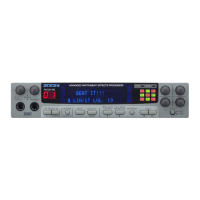
Do you have a question about the Zoom 9030 and is the answer not in the manual?
| Brand | Zoom |
|---|---|
| Model | 9030 |
| Category | Computer Hardware |
| Language | English |
Covers AC adapter usage, device handling, and battery replacement warnings for safe operation.
Advice on suitable operating environments and proper cable connection procedures.
Guidance on avoiding electronic noise and ensuring proper device function near other equipment.
Instructions for safely cleaning the unit using specified materials.
Explains terms, controls, and provides a guided tour of the unit's functions.
Outlines Play, Edit, Utility modes, and Example Applications for comprehensive understanding.
Defines effect modules, types, patches, parameters, pages, and operating modes.
Details gain, headphone volume, patch selection keys, indicators, and the display.
Covers function buttons, data entry controls, and the power switch.
Describes AC, Remote, MIDI, Output, Send/Return, and Input terminals for connection.
Step-by-step guide for connecting the unit and performing initial setup procedures.
Covers choosing patches, bypassing effects, and adjusting master volume.
Details entering edit mode, selecting modules, changing parameters, and navigation.
Explains real-time modulation and turning effect modules off.
Allows comparison of edited patches with their original settings.
Procedures for storing edited patches to user memory.
Covers selecting patches, bypassing effects, and changing master level.
Saving master level changes or copying patches to new locations.
Explains modules, types, signal paths, and routing configurations.
Details the edit display, parameter changes, page selection, and module control.
Parameters for COMP, LIM, and EXT modules, detailing their functions.
Parameters for DIST, OD, and CRU effects, describing their tonal characteristics.
Details for EQ types (4-band, 3-band) and the ENH effect.
Parameters for simulating amplifier characteristics for guitar and bass.
Details for PIT, PHA, and FLG effects, covering pitch shifting, phasing, and flanging.
Details for CHO and AWA effects, focusing on chorus and auto wah.
Details for CRY and MET effects, covering unique pitch modulation and ring modulation.
Details for DBL and COF effects, covering delayed repeats and comb filtering.
Details for TRM, OCT, and PWA effects, including tremolo, octave shift, and wah.
Parameters for various EFF2 effects including pitch, phase, chorus, and flanger variants.
Parameters for EFF2 effects including Cry 2, Tremolo 2, Step, and Auto Pan Pot.
Details for the DEL effect, covering delay time, feedback, and dampening.
Details for HPS effect, enabling diatonic harmonies based on scale settings.
Parameters for AFL, BND, and PIC effects, covering envelope-triggered flanging and pitch modulation.
Details for SCR, BOM, and ZIT effects, including vocoder-like sound, explosive effects, and sitar simulation.
Details for RV1 and RV2 effects, covering reverb time, pre-delay, and room size.
Details for ER1 and ER2 effects, simulating early reflections and ambience.
Details for MTD effect, allowing variable tap intervals and patterns.
Details for PPD effect, creating stereo delay repeats.
Explains User memory, ROM memory, and buffer types (Edit, Recall, Compare).
How patch data is copied and moved between memory and buffers.
Covers output mode, MIDI channel selection, and table banks.
Details on naming patches and MIDI bulk dump/load operations.
Restoring previously edited patches and accessing factory ROM presets.
Memorizing MIDI program change numbers for patch assignment.
Viewing received MIDI control changes for real-time modulation source selection.
Setup and functions for 8050 integration, including patch selection and bypass.
MIDI control and modulation using a synthesizer's keyboard and wheel.
Lists effect programs, memory, input/output specs, dimensions, and weight.
Describes display, MIDI ports, power supply, and the unit's block diagram.
Details on channel voice messages sent (CONTROL CHANGE, PROGRAM CHANGE) and received.
Covers identity requests/replies, patch dumps, and data conversion methods.
Overview of MIDI capabilities, including transmitted/recognized messages and modes.